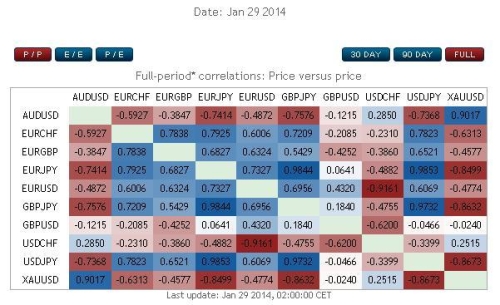What is a Forex Correlation?
A correlation is a measure of how much one currency moves with another. Correlations will run between -100 and +100, the former meaning they move in opposite directions to one another, and the latter meaning they move in the same direction.
The number between -100 and +100 shows the strength of the relationship. -100 shows two different pairs always moved inversely to each other over the period being tested. On the Daily Forex Stats page you can test correlations over varying lengths of time, and different time frames such as hourly, daily or weekly data. A reading of +86 shows there is a very strong correlation between two currency pairs–they move in the same direction very
often, but not all the time.
Today Correlations,01/29/2014

A +100 correlation means two pairs move in the same direction. A -100 correlation means the pairs move in opposite directions. A correlation of 0 (zero) or a small positive or negative number (such as -30 or +25) means the pairs have no real correlation and if they do move together it is more likely to be random than anything significant. Typically a correlation of -/+ 70 is significant and noteworthy, while -/+ 80 is a strong correlation (or strong inverse correlation if negative).
Correlations do not measure magnitude. For example, the USDJPY and GBPJPY have a +97.32 correlation based on the chart below. They usually move in a similar direction, but that does not mean they move the same amount. Based on volatility data (a separate stat shown on the Daily Forex Stats page) the USDJPY currently moves 72.7 pips while the GBPJPY moves 137.4
pips per day. This is important when hedging and attempting to control risk, discussed later.
Currency Correlations
What is a Forex Correlation?
A correlation is a measure of how much one currency moves with another. Correlations will run between -100 and +100, the former meaning they move in opposite directions to one another, and the latter meaning they move in the same direction.
The number between -100 and +100 shows the strength of the relationship. -100 shows two different pairs always moved inversely to each other over the period being tested. On the Daily Forex Stats page you can test correlations over varying lengths of time, and different time frames such as hourly, daily or weekly data. A reading of +86 shows there is a very strong correlation between two currency pairs–they move in the same direction very
often, but not all the time.
Today Correlations,01/29/2014

A +100 correlation means two pairs move in the same direction. A -100 correlation means the pairs move in opposite directions. A correlation of 0 (zero) or a small positive or negative number (such as -30 or +25) means the pairs have no real correlation and if they do move together it is more likely to be random than anything significant. Typically a correlation of -/+ 70 is significant and noteworthy, while -/+ 80 is a strong correlation (or strong inverse correlation if negative).
Correlations do not measure magnitude. For example, the USDJPY and GBPJPY have a +97.32 correlation based on the chart below. They usually move in a similar direction, but that does not mean they move the same amount. Based on volatility data (a separate stat shown on the Daily Forex Stats page) the USDJPY currently moves 72.7 pips while the GBPJPY moves 137.4
pips per day. This is important when hedging and attempting to control risk, discussed later.

